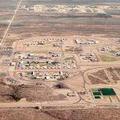 為了響應世界環境日,聯合國環境規劃署5日出版了一份最新報告《全球荒漠展望》,報告中指出,全球氣候變遷、監獄和觀光所導致的大量水資源需求,以及農地灌溉造成的土壤鹽化,都在改變全球的荒漠生態。而地處亞洲和美國西南部的城市將可能是此效應下最大的受害者。
為了響應世界環境日,聯合國環境規劃署5日出版了一份最新報告《全球荒漠展望》,報告中指出,全球氣候變遷、監獄和觀光所導致的大量水資源需求,以及農地灌溉造成的土壤鹽化,都在改變全球的荒漠生態。而地處亞洲和美國西南部的城市將可能是此效應下最大的受害者。
該報告中認為,全球與區域性的不穩定情勢將反應在荒漠環境,因為將來會有越來越多的軍事訓練基地、監牢與難民營將進駐荒漠地區。
《全球荒漠展望》是聯合國《全球環境展望》系列評估報告首次納入荒漠的主題。報告中說:「上述的侵入性設施將導致越來越多的人口進入荒漠地區,儘管這可為當地帶來可觀的收入,並可改善當地設施,但這同時也造成『生態足跡』負荷加重,尤其是在水資源方面。而在當前充滿衝突的全球競爭情勢,往後此類設施的投資將會持續,甚至更為成長。」
今年是聯合國國際沙漠與荒漠化年。2006年世界環境日的主要慶祝活動在阿爾及利亞首都阿爾及爾舉行,主題為「莫使旱地變荒漠」。
在阿爾及利亞的蓋爾達耶,世界環境日的慶祝活動重心在一場關於荒漠化和永續經營的國際論壇,同時也有大街上的遊行、舞蹈等節慶活動。
聯合國環境規劃署強調說,若能謹慎管理荒漠環境,將可預期會有正面效果。
聯合國環境規劃署副執行主任柯克海爾表示:「如果能針對荒漠所擁有的巨大太陽能潛力,發展出經濟上可行的運用方式,那麼未來全世界就能免用石化燃料。同時,如果審慎管理的話,以荒漠自然環境為基礎的觀光業,也能讓世界上某些最貧窮地區的居民擁有新的遠景和視野。」
「全球荒漠展望」報告中的關鍵事實
氣候變遷:報告中指出:「在某些地區可能有對於水源供應、人類以及荒漠動植物等涵意重大的全面性變化,除非能戲劇化地減輕溫室氣體的排放。」
更廣泛的水資源議題與農業問題:為提供飲用水給農業和移民,甚至退休度假勝地等,某些在數百萬年前即已形成的地下水資源遭汲取的情況不斷增加。此份報告建議利用古時精妙的水管理方法,像是北非的坎那特和富加拉、巴基斯坦的坎兒井等地下水渠系統,也許能為未來提供一些永續經營的選擇(譯註1)。
生物多樣性:此份報告警告,「帶著空調的荒漠商隊,隨著獵人進入阿拉伯、哈薩克和蘇丹荒漠各處。」可能帶來的衝擊包括集中在荒漠山區區域的新開道路、移民住地擴張及其他公共建設發展所造成的影響。報告中催促各界採取行動保護荒漠野生動植物。
 Global climate change, high water demands by prisons and tourism, as well as salt contamination of irrigated soils are changing the world's deserts, finds a new report launched today by the United Nations Environment Programme (UNEP) to mark World Environment Day. The biggest casualties may be cities in the deserts of southwestern Asia and in the southwest United States.
Global climate change, high water demands by prisons and tourism, as well as salt contamination of irrigated soils are changing the world's deserts, finds a new report launched today by the United Nations Environment Programme (UNEP) to mark World Environment Day. The biggest casualties may be cities in the deserts of southwestern Asia and in the southwest United States.
Deserts will feel the pressure of global and regional instability, which the report forees will lead to more military training grounds, prisons and refugee holding stations.
"These intrusions import many people into deserts, generate considerable income and help upgrade infrastructure but have large environmental footprints, particularly with respect to water. In an insecure and competitive world, this kind of investment will continue, even grow," according to the UNEP report, The Global Deserts Outlook," the first thematic report in the Global Environment Outlook series of environmental assessments by UNEP.
This is the United Nations International Year of Deserts and Desertification. The main World Environment Day celebrations for 2006 are being held in the Algerian capital Algiers with the theme "Don't Desert Drylands!"
In the Algerian city of Ghardaia, World Environment Day celebrations centered on an international forum on desertification and sustainability as well as street festivities with a parade and dancing.
UNEP took care to emphasis the positive results that can be expected with careful management of desert environments.
“If the huge, solar power potential of deserts can be economically harnessed the world has a future free from fossil fuels," said Kakakhel. "And tourism based around desert nature can, if sensitively managed, deliver new prospects and perspectives for people in some of the poorest parts of the world."
Some Key Facts from the Global Deserts Outlook
Climate Change: "Profound changes with important implications for water supplies and people, and desert plants and animals, are likely in some regions unless greenhouse gas emissions are dramatically reduced," the report states.
Wider Water Issues and Agriculture: Underground water supplies, some formed over the course of a million years, are increasingly being drained of water for agriculture and settlements, including retirement resorts. The report suggests that ancient, ingenious methods of water management such as underground channels known as qanats and foggara in North Africa and karez in countries like Pakistan, might offer sustainable options for the future.
Biodiversity :"Large convoys of air conditioned caravans follow hunters across the deserts of Arabia, Kazakhstan and Sudan," the report warns, urging action to protect wildlife in deserts.
Probable impacts include those created by new roads, expanding settlements and other infrastructure developments that concentrate around desert montane areas.
※譯註1:法拉吉(Falaj)地下水渠系統中的道迪型(Daudi Aflaj),又稱坎那特(Qanat)是一種地下水渠。此型舖挖由一段段寬0.5~1公尺,高0.5~2公尺連接地下通道,深度最深離地表約50公尺。它的特徵在寬延長度(3~12公里)與終年水流。道迪型在伊朗與其它伊斯蘭教國家稱為坎那特,阿富汗巴基斯坦叫Karez,新疆叫坎兒井,北非國家稱Foggara。資料與剖面圖請見:http://0rz.net/a51u4; http://Orz.net/481up
全文及圖片詳見 http://ens-newswire.com/ens/jun2006/2006-06-05-02.asp


